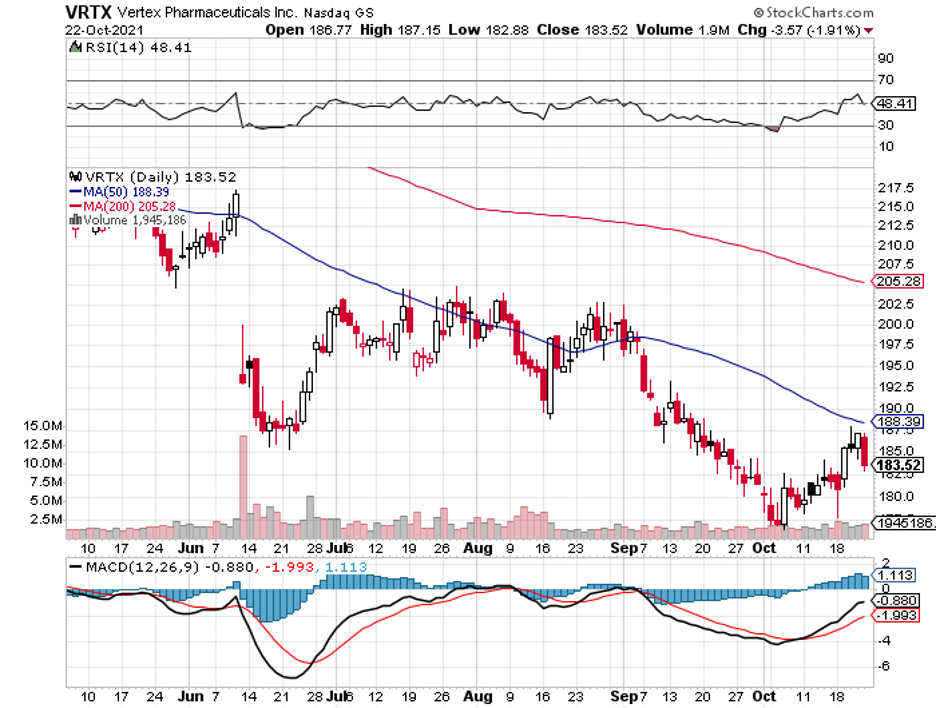Investors have a myriad of biotechnology stocks to choose from. However, most of these options are still in the developmental stage for their first blockbuster product that can hit at least $1 billion in sales annually.
Then, there are biotechnology companies like Vertex Pharmaceuticals (VRTX).
Vertex has a storied history of launching blockbuster names in the market for rare and hard-to-treat diseases.
Among the products in its portfolio, what stands out is Vertex’s work on cystic fibrosis (CF) treatments.
CF is an incurable genetic condition that can damage the lungs and the pancreas. So far, Vertex has four CF treatments available and holds 97% of the market share worldwide, valued at roughly $6.36 billion in 2020.
The company’s latest CF treatment, Trikafta, is already projected to generate roughly $5 billion in sales after only less than 2 years since its release.
Thus far, Vertex has reported an annualized sales run rate of $7.2 billion in its second-quarter earnings report for 2021. This number is expected to climb higher as the company increases its penetration rate in the CF market in the coming years.
Given its history and trajectory, Vertex is projected to generate $10 billion to $10.5 billion in sales for its CF franchise by 2024.
Considering the lucrative CF market’s potential, it no longer comes as a surprise that more and more competitors are entering the space. However, none can even be considered as a close second to Vertex.
AbbVie (ABBV) partnered with Galapagos (GLPG) to come up with a combination CF treatment a few years back, only to get stalled in Phase 2 trials.
It remains to be seen if AbbVie, which eventually acquired the entire CF line from Galapagos, will be able to develop a drug worthy of challenging Vertex’s dominance in the arena.
The driving force behind Vertex’s success is its operating model, which works overtime to exhaust all resources to protect its CF revenue.
Throughout the years, the company has been consistent in its efforts to keep developing innovative CF treatments and expanding its coverage to include more mutations.
In turn, these new drugs all but guarantee that Vertex enjoys a stable and secure cash flow for years.
For example, the IP protection for Trikafta will reach up to the late 2030s. If innovations on the drug are discovered, then this can very well extend into the 2040s.
Despite the overwhelming success of its CF franchise, Vertex knows not to rest all its eggs in one basket.
The company has been working on expanding its expertise. A telltale sign of this decision is its burgeoning partnership with CRISPR Therapeutics (CRSP).
So far, the two have created a promising gene-editing treatment, CTX001, which targets rare blood diseases and sickle cell disease.
Looking at their timeline, the therapy could be ready for regulatory review by 2023.
Other than CTX001, Vertex and CRISPR have been developing several mRNA-based treatments currently under Phase 2 trials.
Among them, the therapies generating the most excitement are the ones targeting pain and rare kidney diseases.
For acute pain treatments alone, the US market is already worth $4 billion. To this day, the non-opioid medication market remains an extremely attractive space.
Needless to say, a product offering an approved safety profile and high efficacy could easily grab the multi-billion sales potential.
Meanwhile, riding on the momentum of its mRNA programs, Vertex also partnered with Moderna (MRNA) to develop more therapies for rare and hard-to-treat diseases.
While its collaboration with Moderna has yet to reveal its prime candidates, there’s a strong possibility that one of them would be a gene therapy for CF.
CTX001’s addressable market is highly lucrative and still exclusive to hyper-specialized companies.
This top-priced orphan gene-editing treatment could rake in annual sales within the range of $3 billion and $4.5 billion. This estimate covers roughly 3,000 to 4,500 patients every year, with average individual spending of $1 million.
Although this price might sound too steep, keep in mind that CTX001 treats lifelong incurable diseases. Typically, patients spend an average of $200, 000 annually.
If successful, this treatment from Vertex and CRISPR could provide a one-and-done answer to the suffering of these patients, justifying the steep price tag.
Overall, I see Vertex as a stock selling a pretty reasonable price.
Considering its relatively young pipeline, though, this should be seen as a long-term investment—one that has been tested and proven to be successful at targeting multi-billion-dollar markets.




